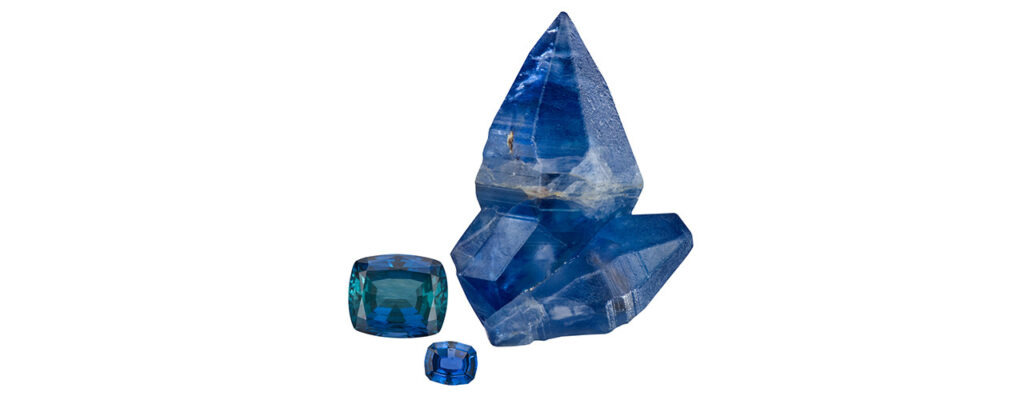September Birthstone
Sapphire
The September birthstone, sapphire, is available in every colour of the rainbow, with the exception of red. Discover more about the birthstone of sagacity, fidelity, and nobility, as well as its origins and history.

The sapphire, which has been prized for thousands of years, is the birthstone for September. The term sapphire typically refers to the blue variation of corundum, whereas ruby is the red version, but this birthstone is available in a wide range of different hues. Sapphires have a long history of being linked to romance, nobility, and fidelity. They are also thought to represent the soul. Blue sapphire is one of the most well-known coloured stones, and the name “sapphire” is derived from the Greek word sappheiros. Continue reading to find out more about the September birthstone, including its origins and locations.
Sapphire Birthstone Meaning & History
Sincerity, truth, faithfulness, and nobility have all historically been associated with the birthstone for September. Sapphire has been used for millennia to embellish kings and priests’ clothing. Ancient Greek and Roman nobility thought that blue sapphires shielded their owners from harm and enmity. Due to their association with Heaven, sapphires were worn by clergy during the Middle Ages. The ancient Persians thought the sky was blue because the world was actually supported by a massive sapphire.
The birthstone for September was also thought to have therapeutic properties. Europeans in the middle ages thought that sapphire could treat eye and plague blisters. It was once believed that the sapphire birthstone could neutralise poison.
One famous sapphire is the 62.02 carat (ct) rectangular step-cut Rockefeller Sapphire, which was discovered in Myanmar (Burma). The stone was recut and remounted over the years after being purchased in 1934 by businessman and philanthropist John D. Rockefeller, Jr. (1874-1960) from an Indian maharaja. The sapphire was first set as a brooch and afterwards as a ring with two triangular-shaped diamond side stones with cut corners. The sapphire engagement ring that Kate Middleton, the current Duchess of Cambridge, received from her son after Princess Diana wore it for the first time and it was set with a 12 carat blue sapphire may be the most well-known sapphire in recent years.
Sapphire is the jewel honouring the fifth and forty-fifth wedding anniversaries in addition to being the September birthstone.
Sapphire is not only the jewel marking the month of September, but also the 5th and 45th wedding anniversaries.G-year milestones.

Sapphire Source
Three historically significant places are Kashmir, Myanmar (formerly Burma), and Sri Lanka for the September birthstone. Along with other nations in Asia and Africa, significant amounts of the September birthstone have also been discovered in Australia, Thailand, Cambodia, Madagascar, and the United States (Montana).
Around 1881, a landslip in the Himalayas uncovered a sizable pocket of velvety ‘cornflower’ blue crystals, which led to the discovery of sapphires in Kashmir. The Maharaja of Kashmir and his troops seized control of the new location as the stunning sapphires spread further south. Numerous thousands of enormously gorgeous crystals were found between 1882 and 1887. The gemstones cut from these crystals gave Kashmir sapphire its status as one of the most sought-after gems in the world.
Since then, there has been a sporadic production, yet beautiful Kashmir sapphire jewellery still periodically appears on the auction market. Another region renowned for producing the birthstone for September is the Mogok region of Myanmar. Dramatic slopes covered in jungle and surrounded by mountains. Ruby deposits frequently contain sapphire as well, though in far lesser amounts than the red stone. The “Burmese” sapphire, as it is still commonly known, can have a deep, intense blue colour that has made it especially valuable. Jadeite jade, spinel, zircon, amethyst, peridot, and other precious gem minerals are also well-known to come from Myanmar.

The birthstone for September has been produced in Sri Lanka for more than 2,000 years. The blue and fancy-colored stones that are extracted from the alluvial gravels of this “jewel box of the Indian Ocean” can exhibit astounding saturation and brilliance. Additionally, the milky white “geuda” sapphires from the island can be heated to a deep blue hue.

Thailand is a significant location for cutting and treating sapphire. In the province of Chanthaburi, sapphire miners work in the deep jungle that is crisscrossed by dirt roads. Sapphires from Myanmar and Cambodia are frequently brought to Bangkok, a significant gem hub, as well as Chanthaburi for cutting and treatment.
Sapphire Care & Cleaning
In terms of hardness, the birthstone for September is a 9 on the Mohs scale. It is extremely durable and lacks cleavage, which can fracture under pressure. This makes it a fantastic option for rings and other mountings that are worn frequently.
The fact that sapphires are frequently treated to enhance their colour or clarity should be noted. Heat treatment is widely used and widely recognised in the industry since the results are permanent. Treatments that are less prevalent, like lattice diffusion, fracture filling, and dyeing, might need specific consideration. The colour created by lattice diffusion can occasionally be so shallow that it could be eliminated if the stone were to be chipped or recut. Even moderate acids like lemon can harm sapphires that are fracture-filled and coloured.
Always enquire as to whether a sapphire has been treated before purchasing it and how.The September birthstone may always be cleaned with warm, soapy water. For untreated, heat-treated, and lattice diffusion-treated stones, ultrasonic and steam cleaners are often safe. Only use a moist cloth to clean material that is fracture-filled or coloured.
September’s birthstone, a rich blue sapphire, is beautifully displayed on a ring with diamond accents.

